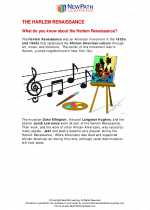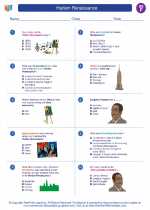Harlem Renaissance
The Harlem Renaissance was a cultural, social, and artistic explosion that took place in the 1920s in the neighborhood of Harlem, New York City. It was a time of great creativity and expression for African American writers, artists, musicians, and intellectuals.
Key Characteristics
- Cultural Expression: The Harlem Renaissance was characterized by a flourishing of African American art, music, literature, and intellectual thought.
- Migration: The Great Migration of African Americans from the rural South to the urban North played a significant role in the development of the Harlem Renaissance.
- Political and Social Activism: Many Harlem Renaissance figures were also involved in civil rights and social justice movements.
Notable Figures
Some of the key figures of the Harlem Renaissance include:
- Langston Hughes: Renowned poet and writer known for his powerful portrayals of African American life.
- Zora Neale Hurston: Author and anthropologist celebrated for her novel "Their Eyes Were Watching God."
- Duke Ellington: Iconic jazz musician and composer who became a prominent figure during the Harlem Renaissance.
Impact
The Harlem Renaissance had a lasting impact on American culture and society. It contributed to the development of a distinct African American identity and helped pave the way for the civil rights movement of the 1950s and 1960s.
Study Guide
- What was the Harlem Renaissance?
- What were the key characteristics of the Harlem Renaissance?
- Who were some notable figures of the Harlem Renaissance?
- What impact did the Harlem Renaissance have on American society?
Studying the Harlem Renaissance provides a deeper understanding of the cultural, social, and artistic contributions of African Americans to American history.
[Harlem Renaissance] Related Worksheets and Study Guides:
.◂Social Studies Worksheets and Study Guides Sixth Grade. Harlem Renaissance
Study Guide Harlem Renaissance
Harlem Renaissance  Worksheet/Answer key
Worksheet/Answer key Harlem Renaissance
Harlem Renaissance  Worksheet/Answer key
Worksheet/Answer key Harlem Renaissance
Harlem Renaissance  Worksheet/Answer key
Worksheet/Answer key Harlem Renaissance
Harlem Renaissance  Worksheet/Answer key
Worksheet/Answer key Harlem Renaissance
Harlem Renaissance 

 Worksheet/Answer key
Worksheet/Answer key
 Worksheet/Answer key
Worksheet/Answer key
 Worksheet/Answer key
Worksheet/Answer key
 Worksheet/Answer key
Worksheet/Answer key

The resources above cover the following skills:
National Curriculum Standards for Social Studies (NCSS)
TIME, CONTINUITY, AND CHANGE
SOCIAL STUDIES PROGRAMS SHOULD INCLUDE EXPERIENCES THAT PROVIDE FOR THE STUDY OF THE PAST AND ITS LEGACY.
KNOWLEDGE - Learners will understand:
Concepts such as: chronology, causality, change, conflict, complexity, multiple perspectives, primary and secondary sources, and cause and effect.
National Center for History in Schools (NCHS)
Historical Thinking Standards
Historical Comprehension
Reconstruct the literal meaning of a historical passage.
Historical Analysis and Interpretation
Analyze cause-and-effect relationships and multiple causation, including the importance of the individual, the influence of ideas.
United States History Content Standards
Era 6: The Development of the Industrial United States (1870-1900)
Massive immigration after 1870 and how new social patterns, conflicts, and ideas of national unity developed amid growing cultural diversity.
The student understands "scientific racism", race relations, and the struggle for equal rights.
The rise of the American labor movement and how political issues reflected social and economic changes.
The student understands how Americans grappled with social, economic, and political issues.
Era 7: The Emergence of Modern America (1890-1930)
How the United States changed from the end of World War I to the eve of the Great Depression.
The student understands how new cultural movements reflected and changed American society.
Era 8: The Great Depression and World War II (1929-1945)
The causes of the Great Depression and how it affected American society.
The student understands the causes of the crash of 1929 and the Great Depression.
The student understands how American life changed during the 1930s.
World History Content Standards
Era 8: A Half-Century of Crisis and Achievement, 1900-1945
The search for peace and stability in the 1920s and 1930s.
The student understands the interplay of new artistic and literary movements with changes in social and cultural life in various parts of the world in the post-war decades.
Major global trends from 1900 to the end of World War II.
The student understands major global trends from 1900 to the end of World War II.